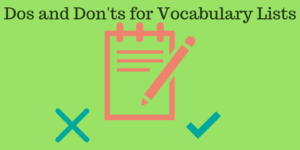Although I have written about my grading policies in the past, my ideas have continued to evolve since these earlier posts. Prompted by a recent conversation on the French Teachers in the US Facebook page, I thought I would share my most recent policies for grading in a proficiency-based classroom.
Step 1: Gradebook
My preferred gradebook configuration is to have five different categories: Reading, Listening, Speaking, Writing and Miscellaneous . I weight each of these categories evenly at 20%. Other people use the modes (Interpretive, Interpersonal and Presentational) as their categories and I think that’s great. I preferred to use the skills rather than modes, because my students and I got more specific feedback this way. I found that a student’s interpersonal speaking and presentational speaking skills were much more congruous than their presentational speaking and presentational writing skills were. If I used Presentational as a category, I would not immediately be clear whether a struggling student needed support for writing or speaking. Note: If I were in a school with standards-based grading, I would eliminate the Miscellaneous category and move the other categories to 25%.
Step 2: Formative Assessments
In my classroom the majority of the each class period was spent on communicative activities that I assessed as follows:
Interpretive Reading: When the students read something in class and completed some type of comprehension-based task, I either gave whole class feedback (providing the correct answers) or collected their work for written feedback. This feedback was usually limited to a score (I scored out of 10 rather than percentages) based on accuracy.
Interpretive Listening: I assigned a lot of Edpuzzles (but only because FluentKey wasn’t yet available!) I used the computer-generated score as a basis for a score out of 10. Because I didn’t expect my students to get all of my questions correct (I designed some questions to encourage my high flyers to stretch), I usually gave a 10/10 for 90% or higher, 9/10 for 80% or higher, etc.
Interpersonal Speaking: I circulated among my students as they worked on interpersonal tasks. Sometimes I filled out a rubric with specific feedback and recorded a score (out of 10) but most times I jotted down notes on a class roster. Occasionally I used these notes to determine a grade. I did not generally assign any interpersonal writing tasks.
Presentational Writing: I often assigned short written tasks based on the interpretive and interpersonal tasks from the lesson and gave basic feedback and a score out of 10.
Presentational Speaking: I seldom assigned a presentational speaking task as a formative assessment. When I did so, I provided feedback and a score out of 10.
In addition to these communicative activities, I occasionally gave a quiz of some kind. For example, if the students had done a pair activity that involved describing pictures to each other, I might describe 5 pictures and have the students identify them. If they had done a reading activity with a partner, I might ask some oral true/false questions about the reading.
At the end of a 4-6 week unit, I had a LOT of scores. They ALL went in the Miscellaneous category. A better name for this category would have been Formative Assessment, but I was leaving myself a little wiggle room for the rare instances that I needed to include something that I didn’t consider to be a formative assessment but that I was required to assign by my department.
Step 3: Summative Assessments
At the end of each unit, I assigned an Integrated Performance Assessment. Each task in the assessment resulted in a separate grade. So for most IPAs I had a grade for each performance category: Interpretive Reading, Interpretive Listening, Interpersonal Speaking and Presentational Writing. If I included a Presentational Speaking task, that would be an additional grade in my Speaking category.
The grades for the IPAs were the only grades that went into my performance categories. In other words, 80% of my grades (all but the formative assessments) came from IPAs.
When I graded my IPAs, I used the following rubrics.
Interpretive Reading: I used the rubric from the ACTFL publication, Implementing Integrated Performance Assessment by Bonnie Adair-Hauck, Eileen W. Glisan and Francis J. Troyan. I assigned 10/10 for students whose work fell in the Accomplished Comprehension category, and 8/10 or 9/10 for Strong Comprehension, a 7/10 for Minimal Comprehension and a 5/10 or 6/10 for Limited Comprehension. I did not assign scores of less that 5/10. (See this article for an explanation of this policy.)
Interpretive Listening: Because I did not use the IPA Interpretive Template for my listening assessments, I developed individual rubrics for my listening tasks. I usually used a graphic organizer or comprehension questions for listening assessment and a rubric something like this:
10: Identifies the main ideas and supports each one with relevant details
9: Identifies the main ideas and supports most of them with relevant details
8: Identifies some main ideas and/or several details
7: Identifies a main idea and a couple of details.
6: Identifies a few details.
5: Is unable to identify a main idea or provide any relevant details.
Interpersonal Speaking: I used this proficiency-based rubric from the Ohio Department of Education.
Presentational Speaking and/or Presentational Writing: I used this proficiency-based rubric from the Ohio Department of Education.
Note: The Interpersonal and Presentational rubrics do not provide a numeric or letter grade. I preferred to just check the relevant boxes to provide feedback to my students. In order to determine a numerical grade for my gradebook, I used this conversion chart:
*In each case (9) represents the ACTFL expectation.
Standards-Based Grading
Many schools are adopting standards-based grading practices. I have created standards-based rubrics for each mode of communication and they are available here: https://www.teacherspayteachers.com/Product/Standards-Based-Rubrics-for-World-Languages-4743987
I know that what worked for me may not work in other environments and I look forward to hearing from other teachers who are willing to share the grading practices they have developed!









